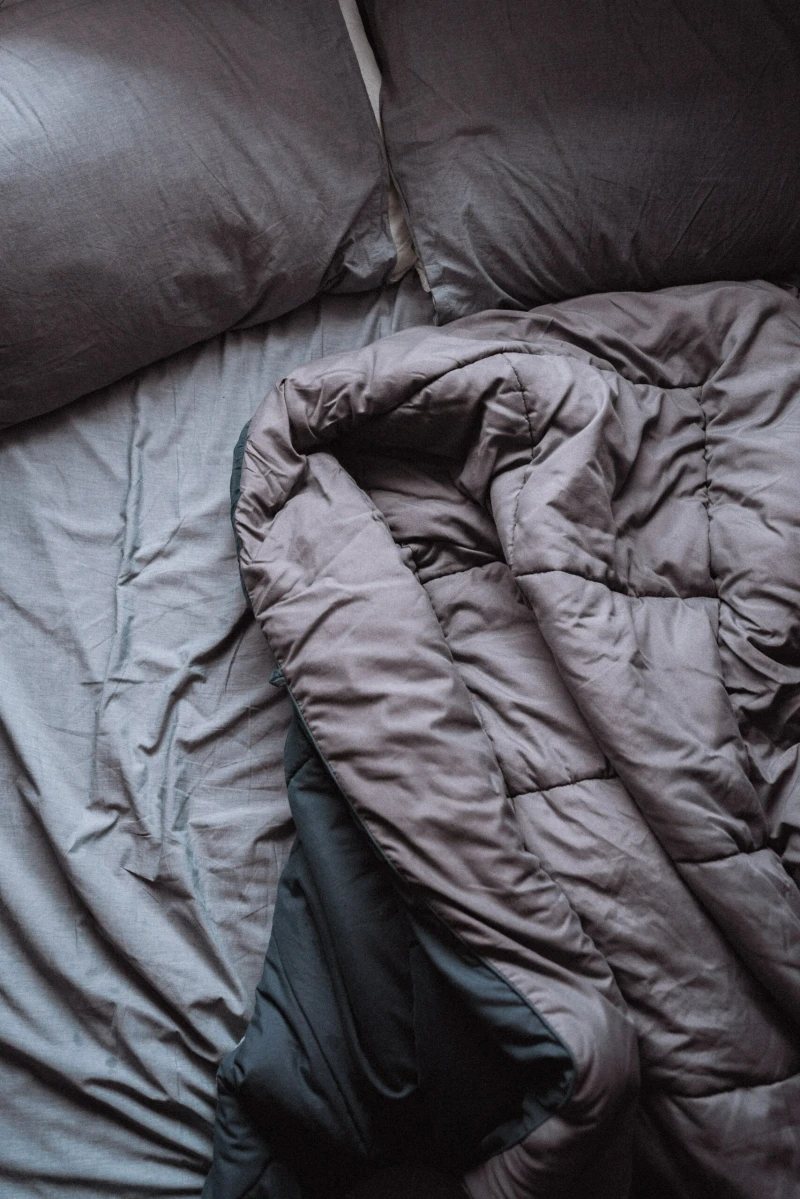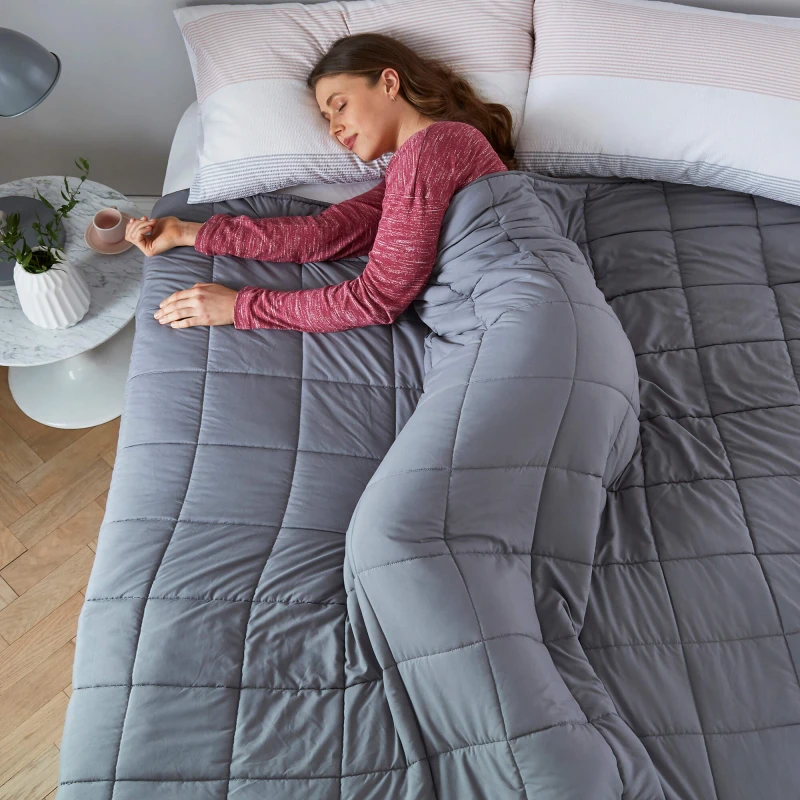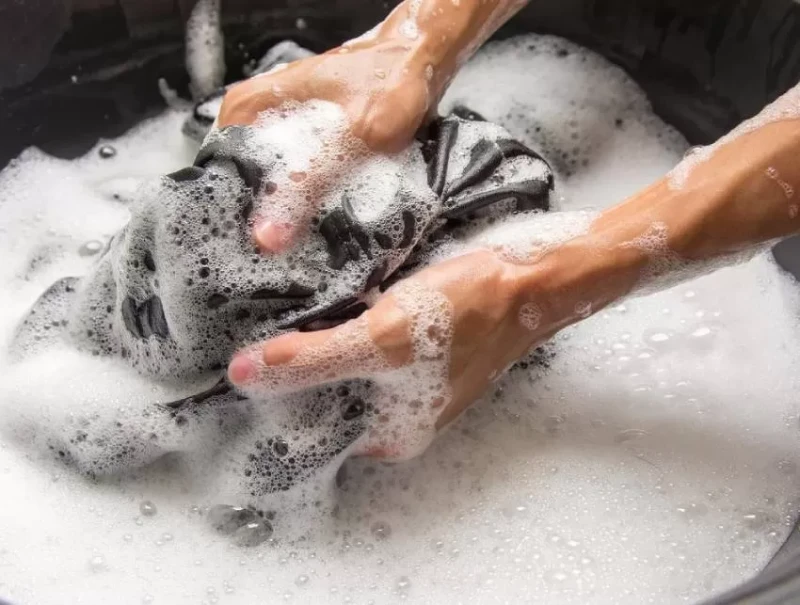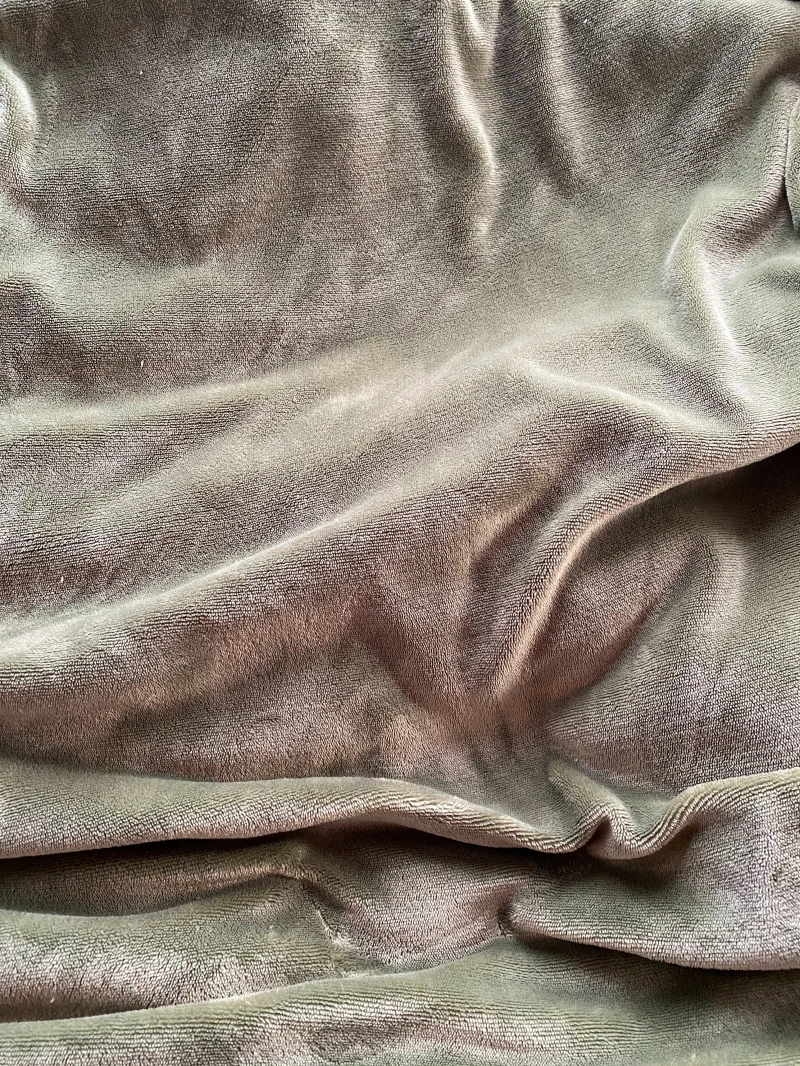The Real Way to Wash a Weighted Blanket (Without Ruining It)
Over the years, I’ve handled just about every type of fabric you can imagine, from super delicate stuff to heavy-duty textiles. But honestly, nothing has been quite as tricky to clean as the weighted blanket. When they first became popular, people would bring them into my shop totally confused. They loved them for sleep and anxiety, but they washed them like a regular old comforter. And that, my friends, was a very expensive mistake.
In this article
See, a weighted blanket isn’t just a heavy piece of bedding; it’s a therapeutic tool. The filling—usually tiny glass beads or plastic pellets—is spread out perfectly to give you that gentle, even pressure. Washing it the wrong way doesn’t just leave a stain; it can completely mess up that balance, turning your $150 comfort object into a lumpy, useless sack. I’ve seen it happen more times than I can count.
That little care tag on the seam is your starting point, but it doesn’t tell the whole story. It has no idea how big your washer is or if you live in a humid climate. My goal here is to give you the practical knowledge that goes beyond the tag—the stuff you learn from experience. We’ll walk through how to clean your blanket safely so it lasts for years and keeps on delivering that comfort you rely on.

First Things First: The Pre-Wash Checkup
Before a single drop of water touches that blanket, you’ve got to do a quick assessment. Seriously, don’t skip this part. Rushing this is the #1 way people ruin their blankets. You need to know exactly what you’re working with, from the fabric and filler to what your own washing machine can actually handle. A five-minute check now can save you a huge headache later.
Know Your Blanket’s Insides
First, let’s figure out what’s giving your blanket its heft. The type of filler is the most important factor in how you can wash it.
- Micro Glass Beads: This is the good stuff. They look like fine, white sand and are the premium choice for a reason. They’re super durable, machine washable, and hypoallergenic. They handle heat pretty well, but I still always recommend sticking to cold water to be safe.
- Plastic Poly-Pellets: Also very common. These are small plastic beads that are washable, but they have one major weakness: heat. Tumble drying them on a hot setting can cause them to melt or warp. If you ever feel sharp or lumpy spots in your blanket, this is probably why.
- Sand or Rocks: You might find this in some budget or DIY blankets. Honestly, if a seam breaks, you’re in for a nightmare. I strongly recommend you only ever spot-clean these blankets. Never submerge them in water.
- Organic Stuff (like rice or beans): If your blanket is filled with any kind of dried grain, it cannot be washed with water. Period. The filling will swell up, spoil, and grow mold. Spot clean only, no exceptions.
And don’t forget the outer fabric! That matters, too.

- Cotton: Great, breathable, and tough, but it’s known to shrink in hot water or a hot dryer. Cold or lukewarm water is the only way to go.
- Minky or Fleece (Polyester): Oh, it’s so soft, but that texture is delicate. High heat can literally melt the ends of the fibers, making your blanket feel matted and rough forever. Also, heads up! Fabric softener is the enemy of minky fabric. It coats the fibers and completely ruins that plush, velvety feel.
- Bamboo or Viscose: Super soft and cool to the touch, but it’s a more delicate fiber. To prevent pilling and damage, you’ll want to use a gentle cycle with cold water.
Respect Your Washing Machine’s Limits
This is where things usually go wrong. Your washing machine manual might claim it can handle a 25-pound load, but a 25-pound load of fluffy towels is a world away from a single, dense 25-pound object. A wet weighted blanket is a concentrated, dead weight that can easily throw the drum off balance during the spin cycle. This leads to that terrifying, violent shaking that can wreck your machine’s suspension or burn out the motor.

As a non-negotiable rule, do not use a home washing machine for any blanket over 20 pounds. And if you have a top-loader with one of those big agitators in the middle, I’d drop that limit to 15 pounds. That agitator can put a ton of stress on the blanket’s seams.
Did you know? A 15-pound blanket can weigh upwards of 40 pounds once it’s completely soaked with water. No wonder home machines struggle!
If your blanket is heavier than that, your best bet is to hand wash it or take it to a laundromat. Their giant, front-loading commercial machines are built for this. Expect to pay around $8 to $12 to use one—a whole lot cheaper than the $300+ repair bill for a new washer motor. Trust me, I had a client learn that lesson the hard way.
How to Actually Clean It: Picking Your Method
Okay, you’ve done your homework. Now it’s time to choose your cleaning method. My advice is always to start with the least aggressive option possible. Here’s a quick rundown to help you decide:

- Spot Cleaning: This is for small spills and smudges. It’s super low effort, takes very little time, and carries almost zero risk to the blanket. It’s always your first choice.
- Hand Washing: This is the go-to for a full, deep clean, especially for heavier or delicate blankets. It’s high effort and takes a lot of time (mostly for drying), but it’s by far the safest way to do a full wash.
- Machine Washing: This is the risky option, only for blankets under 20 pounds that have a care tag that explicitly says it’s okay. The effort is lower, but the risk of damage to the blanket and your machine is much higher.
Method 1: Spot Cleaning (Your Best Friend)
For little drips and dirty spots, spot cleaning is perfect because it avoids the drama of a full wash. The trick is to act fast before the stain decides to move in permanently.

What you’ll need:
- A mild, clear detergent. Think gentle stuff like Woolite, Dreft, or another brand designed for delicates. A few drops of clear dish soap also work in a pinch. You can find these at any grocery store for about $8-$15 a bottle.
- A couple of clean, white microfiber cloths.
- A small bowl of cold water.
- An old, soft toothbrush for stubborn spots.
Here’s how you do it: Mix a few drops of detergent in the water. Dip a cloth into the sudsy part. Gently blot the stain, working from the outside in to keep it from spreading. And please, do not rub or scrub! That just grinds the stain deeper. For a tough spot, you can use the soft toothbrush to lightly work the suds in. Then, use a new, clean, damp cloth to blot the area and “rinse” out the soap. Let it air dry, maybe with a fan pointed at it to speed things up.

Method 2: Hand Washing (The Safest Deep Clean)
If your blanket is too heavy for your machine or just needs a really good wash, hand washing is the way to go. It’s a bit of a workout, but you have total control.
Your bathtub is the perfect place for this. Just make sure you give it a good scrub first to get rid of any soap or cleaning residue. Fill the tub with a few inches of lukewarm water, add a small amount of mild liquid detergent (no more than a quarter cup), and lay the blanket in. Let it soak for about 30 minutes.
Then, gently press and squeeze the blanket with your hands. Or, even better, get in the tub with clean feet and walk all over it. This mimics a washer without the damaging force. Drain the soapy water, press the blanket to squeeze it out, and refill with clean, cool water to rinse. You’ll probably need to do this 2-3 times until no more suds appear.

Now for the hard part: getting the water out. Never, ever wring or twist a weighted blanket. You’ll rip the internal stitching. Instead, fold it into a rectangle and press down hard with your body weight. Then, lay it on a couple of big, old towels, put more towels on top, and roll the whole thing up like a giant burrito. Stand on the roll to squeeze even more water out into the towels. Quick tip: This can be a two-person job to avoid straining your back. Grab a partner if you can!
Method 3: Machine Washing (If You Absolutely Must)
If your blanket is under the 20-pound limit and the tag gives you the green light, you can use your machine. But you have to be careful. Before you do anything, check every inch of the seams for tiny holes. One small tear can turn into a disaster, spilling thousands of glass beads into your machine and destroying it.

When you load it, spread the blanket out evenly around the drum and add a couple of bath towels to help balance the load. Then, use these exact settings:
- Cycle: Gentle, Delicates, or Hand Wash.
- Water Temp: Cold. Always cold.
- Spin Speed: Low, or even better, No Spin.
- Detergent: A mild liquid detergent. No powders, no bleach, and absolutely no fabric softener.
Method 4: A Duvet Cover (The Smartest Move of All)
Honestly, the best way to wash a weighted blanket is to… not wash it. I tell everyone to get a removable duvet cover made specifically for weighted blankets. You can find them on Amazon, at Target, or directly from blanket brands for about $30 to $70. It’s a total game-changer.
The cover takes all the daily grime, sweat, and oils. When it gets dirty, you just unzip it and toss it in the wash with your sheets. A common worry is the blanket bunching up inside, but a good cover will have ties on the inside corners that loop through the tabs on the blanket, holding it perfectly in place. This simple purchase means you might only have to wash the heavy inner blanket once a year, if that. It’s the single best thing you can do for your blanket and your sanity.

Drying: Where Patience Pays Off
Drying it wrong is just as bad as washing it wrong. A blanket that isn’t 100% dry will get that awful mildew smell.
The safest method is to air dry it flat. Never hang a wet weighted blanket from a clothesline; its own weight will stretch it out and tear the seams. Instead, lay it across a few sturdy drying racks or a clean patio table, making sure its weight is supported evenly. This isn’t quick—it can take 24 to 48 hours. Point a fan at it and flip it every few hours to make sure air gets to every part.
If you must use a machine dryer, do it with extreme caution. First and most importantly, clean your lint trap! A heavy, slow-tumbling item can be a fire risk. Use the lowest heat setting (or an air-fluff, no-heat cycle) and toss in a few wool dryer balls to improve airflow. Don’t just set it and forget it. Check it every 20-30 minutes, take it out, shake it, and feel for hot spots. It’s a hands-on job.

Troubleshooting Common Problems
- The filling is all clumped in one corner. An internal seam probably ripped. You can try to massage the filler back into place and sew a new seam on the outside with heavy-duty thread, but sometimes the damage is done.
- It smells musty. That’s mildew from not drying completely. The only fix is to rewash it, adding one cup of white vinegar to the final rinse cycle to kill the spores and odor. Then, be absolutely certain it gets 100% dry.
- I found a small leak! Fix it immediately with a needle and strong thread. A small leak quickly becomes a huge mess.
When you’re not using it, store your blanket by folding it loosely in a breathable cotton bag—never a plastic bin, which traps moisture.
By treating your weighted blanket like the investment it is, you’re not just cleaning fabric; you’re preserving an important tool for your own well-being. A little extra care goes a long, long way.
Inspirational Gallery with Photos
The duvet cover dilemma: A weighted blanket with an integrated, non-removable cover feels seamless, but means you must wash the entire heavy item every time.
The separate cover solution: A blanket with a removable duvet cover is far more practical. You can wash the cover weekly with your regular laundry, preserving the inner blanket’s integrity and drastically reducing the hassle of deep cleaning.
For convenience, the separate cover is almost always the better choice.
Deep Pressure Stimulation (DPS), the therapeutic principle behind weighted blankets, is known to activate the parasympathetic nervous system. This helps the body shift from a state of alert ‘fight or flight’ to a calmer ‘rest and digest’ mode.
Keeping your blanket clean and well-maintained ensures this therapeutic tool remains a comforting, effective part of your wellness routine, free from distracting dirt or odors.
My weighted blanket smells a bit musty, but it’s not actually dirty. What’s going on?
This is almost always a sign of trapped moisture from improper drying. Even if it feels dry to the touch, moisture can be locked deep within the filling. Tumble drying on a no-heat setting with a few wool dryer balls can help circulate air. If the care tag forbids a dryer, hang it in a dry, well-ventilated area for an extra 24-48 hours, flipping it over halfway through.
The single best investment for your weighted blanket? A dedicated duvet cover. It’s the first line of defense against sweat, skin oils, and accidental spills. Brands like Baloo offer covers in materials like French linen that are easy to machine wash, meaning you can keep your sleep environment fresh without ever having to wrestle the heavy inner blanket into the machine.
- Prevents dust mites and allergens from settling in the fabric.
- Maintains the even distribution of the filler by avoiding bunching.
- Keeps the blanket fresh and ready for immediate use.
The secret? Proper storage. Always fold your blanket flat and store it in a breathable cotton bag, never in a sealed plastic container where humidity can get trapped and cause mildew.
Don’t underestimate the role of the outer fabric in your comfort. A plush minky cover provides maximum coziness, ideal for colder nights. A crisp, stonewashed cotton offers a classic, breathable feel. For hot sleepers, the open-weave, Tencel-based design of a Bearaby Napper is a game-changer, allowing for airflow that traditional quilted designs can’t match.
A 15-pound weighted blanket can easily weigh over 40 pounds when fully saturated with water.
This is why checking your home washing machine’s weight capacity is non-negotiable. Most standard home machines can handle up to 20 pounds. Pushing this limit can strain the drum and motor, risking a costly repair. For heavier blankets, a trip to a laundromat with industrial-sized machines is the safest bet.
For small spills like coffee or tea, a full wash isn’t always necessary. You can spot-clean effectively to extend the time between deep cleans.
- Gently blot the stain with a clean, dry cloth to absorb as much liquid as possible.
- Mix a small amount of a gentle, pH-neutral detergent (like Woolite) with cold water.
- Dab the solution onto the stain using a microfiber cloth—never rub, as this can push the stain deeper and damage fibers.
- Rinse by dabbing with a cloth dampened with plain cold water.
Over-drying is just as harmful as using high heat. Even on a low-heat setting, tumbling a weighted blanket for too long can stress the seams and fabric from the constant friction of the heavy filler.
There’s a simple sensory pleasure in slipping under a freshly laundered weighted blanket. The fabric feels crisp and cool, the gentle scent is calming, and the weight seems to settle more perfectly, free from the dust and worries of the week. It’s a complete sensory reset for your sleep space.










